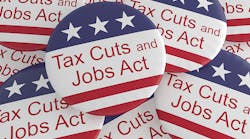The Tax Cuts and Jobs Act is a little more than two weeks old now, already in full swing for individuals and businesses alike. And while 16 months remain until any of us need to file with new rates and deductions in mind, it’s never too early to talk with the professionals.
We continue our ongoing coverage of the bill and its effect on manufacturing with some perspective from Jim Brandenburg of Sikich. Brandenburg specializes in corporate and partnership tax law, mergers and acquisitions, and tax legislation. If you have a question about your corporate finances, he most likely has an answer.
Unlike most of us, he has also already read through all of the new tax bill.
So, how will the bill affect manufacturers? Every company is different, of course, but Brandenburg has some helpful pointers no matter the size of your floor or the scope of your goals.
IndustryWeek: By now, I think everybody knows the highlights of the new tax bill, especially the lower rates for both C Corporations and pass-through entities. One of the more overlooked aspects seems to be that businesses will no longer be able to immediately deduct the full cost of some capital equipment after 2022.
Jim Brandenburg: They wanted as part of the legislation to have 100% expensing for any of the capital expenditures for equipment purchases, and that’s effective back to September 27. They wanted to make that permanent — or at least permanent for the indefinite future — but just due to some of the budgetary rules, they were limited to this five-year period. After that, it phases out and goes from 100% to 80%, 60%, 40% and 20%.
The general rule with depreciation before they put in this expense stipulation was that the depreciation life was five to seven years for most properties. You’ll still be able to write off that equipment, it just may be a longer life once you get to 2022. … So it’s not that equipment won’t be depreciable in the future, it just may not be as accelerated as it is now. For manufacturers, it does provide some certainty, at least for that five-year period, that they know what the rules are and they are able to take that 100% expensing. That does provide the ability to plan over the next several years.
IW: What else really jumped out to you while reading through over the last couple weeks?
JB: First, and I think this got a lot of attention, is just the tax rates in general. For a C Corporation, the rate is cut from 35% to 21%, and then for pass-through businesses, it goes from roughly 40% down to approximately 30%. These new tax rates will allow some additional capital for manufacturers to purchase new equipment, hire new employees, expand the business. They will just provide some relief for manufacturers.
Second is this capital expenditure at 100%. One thing that’s interesting that was put in is when you had the bonus depreciation, it was just for new equipment purchases. Now with this bill, the equipment can be new or used — it doesn’t have to be new anymore, just new to your company. Again, the effective date is back to September 27, 2017, so it’s one of the few provisions in the bill that is retroactive and applies for the 2017 tax year. Any of the fourth-quarter purchases will be able to take advantage of that 100% expensing. That’s another key item.
As we’re digesting what’s in the bill, two items that I think are important for manufacturers that were not in the bill: One is the LIFO inventory method that some manufacturers use. A number of manufacturers have used that, where they have increasing prices over the years, LIFO provides a tax benefit for it. There was some discussion and speculation that as part of the tax reform, the LIFO benefit could be taken out by this tax bill. It was not in the bill, so LIFO is still available for companies that have used that method. The other one is the R&D credit. Manufacturers that develop new products and processes can take advantage of the R&D credit that was retained by the bill. Those were two items that were favorable before the bill and are were not changed by it.
IW: What surprised you? Anything that didn’t make it through the early talks? Anything that got added late?
JB: It was an involved legislative process. As far as what could affect manufacturers, a couple come to mind. One is that with the rates we discussed earlier, a 20% deduction applies for pass-through businesses — whether it’s an S Corporation, or a partnership, or a small proprietor. That follows more along the lines of what the Senate had proposed originally. … One thing that was a surprise was the alternative minimum tax item, which affects businesses and individuals. Congressional leaders really initially wanted to get rid of the AMT for both the corporate and the individual. The AMT has been repealed starting next year for corporations, but it was retained for individuals.
One other item that manufacturers could take advantage of: They came up with a new tax credit that is initially going to be only for 2018 and 2019, a family leave credit. If a company has a family leave program or a sick leave program, if they pay their employees at least 50% of their regular wage, they can receive a tax credit for a portion of their wage when an employee is out on family leave or sick time. That would apply to C Corporations or pass-through businesses.
IW: Anything else?
JB: There is a new limitation on the ability to deduct interest. It’s almost essentially 30% of your EBITDA, if you will, or your adjustable taxable income. So if you’re a highly-leveraged manufacturer that maybe has a lot of debt, your ability to deduct interest may be limited now to the extent that your interest is above the limitations of what you can deduct in a year. There had not been a limitation in the past. Now there is one. Something just to be mindful of.
IW: Obviously, the longer-term effects of this bill are tough to predict. In the nearer term, though, this seems like a pretty good deal for big companies, small companies, no matter — as long as they dive in and explore how this will benefit them.
JB: There are incentives across the board. It isn’t a tax bill that favors only small businesses, or only large businesses. Going forward over the next several years, one thing that some companies should look at is switching from an S Corporation to a C Corporation. Some companies will be looking at their entity status as to what makes the most sense for them.
1986 was the last major tax-reform bill, and with that one, the individual rates used to be above the corporate rates. The individual rate dipped with that bill, and there were a number of businesses, especially closely-held businesses, that switched from C Corporation status to S Corporation just because their income was avoiding a double tax and also being taxed at a lower rate. This bill is different because the corporate rates are dropping under the individual rates, so some companies should explore going toward a C Corporation route.




